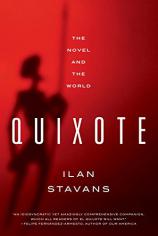Quixote: The Novel and the World
Review
Quixote: The Novel and the World
There are the classics of world literature, and then there are the giants. Undeniably one of those giants is DON QUIXOTE, the early 17th-century masterpiece by Spanish author Miguel de Cervantes. Like the King James translation of the Bible or the works of Shakespeare, EL QUIJOTE, as the novel is affectionately known, has had considerable influence on the humanities of the western world.
In QUIXOTE, scholar and Cervantes fan Ilan Stavans explores and examines some of the almost immeasurable ways that the novel has entertained, perplexed and inspired readers, as well as artists, philosophers and others, for centuries. It seems a daunting task, but Stavans organizes his surprisingly slender volume into two main sections after a nicely personal preface --- “The Novel” and “The World” --- and goes from there.
Stavans first introduces us to Cervantes himself, known mostly as a barely successful playwright in his lifetime, and outlines the basic plot of his sophisticated novel. Cervantes created, in his main character Alonso Quijano, a middle-aged nobleman whose mind and heart are full to bursting of the chivalric and romantic tales he spends his time reading. It is not necessary to have read DON QUIXOTE to understand or enjoy QUIXOTE, but it helps.
"QUIXOTE is immensely readable and endlessly fascinating. Researching and writing it was clearly a labor of love for Stavans, and his admiration for his subject is apparent and infectious."
Because Don Quixote and his sidekick, a rotund farmer named Sancho Panza, have become archetypes in literature, even those unfamiliar with the novel itself will find them both to be recognizable. As Stavans reminds or informs us, the two show up across the vast landscape of western art and letters: they have inspired other pairings such as Sherlock Holmes and Dr. Watson, Abbott and Costello, Frodo and Sam Gamgee, and even Bert and Ernie from “Sesame Street” and the Star Wars robots R2-D2 and C-3PO. We are so used to seeing this partnership of the dreamy intellectual with the practical realist that we rarely consider its origins. This is just one of the many reasons QUIXOTE is so interesting: it gives us reason to consider and reconsider both Cervantes' great work and its vast and lasting legacy.
In the first half of the book, Stavans also discusses DON QUIXOTE as a novel that ushers in the modern age by playing with and expanding upon some baroque themes like self-referentiality, thus blurring the “boundaries between fiction and reality.” Less philosophically, Stavans even breaks down the word and letter count of the novel and lists its punctuation (690 exclamation points!). This attention to detail is far from trivial as he unpacks the meaning and structure of the novel, and its effect on culture, thought and language.
It is the novel's impact on ideology and the arts in Spain and beyond that the second part of QUIXOTE tackles. Stavans begins by explaining the idea of Quijotismo, an ideology of rebellion wherein one sacrifices one's life in the service of a dream. This idea is implicit in DON QUIXOTE and has infused Hispanic culture since its publication. Stavans catalogues how the novel has become part of the Spanish and greater Hispanic cultural landscape by introducing just some of the myriad figures who have responded to it with great works of their own. From Borges to Picasso, Flaubert to Kafka, Steinbeck to Faulkner, writers and artists have incorporated the themes, dreams, characters and illusions of the original into their own work. “EL QUIJOTE is a mirror,” Stavans writes, “its implications, its lessons always in the eye of the beholder. To some, the novel is a manifesto for human freedom; to others, it is a treatise on psychiatry. Eternally fluid in its message, it can be seen to advocate individualism or collectivism, to view human nature as resilient or malleable. Therein, perhaps, lies the reason for its continued success.”
The fluidity Stavans admires in EL QUIJOTE is present in his own book as well. He smartly presents readers with all the possibilities inherent in the novel and points out the historical and cross-cultural references, but allows readers to draw their own conclusions about meaning. QUIXOTE is immensely readable and endlessly fascinating. Researching and writing it was clearly a labor of love for Stavans, and his admiration for his subject is apparent and infectious. This is an extraordinary book that’s as entertaining, informative and compelling as the novel it honors.
Reviewed by Sarah Rachel Egelman on October 9, 2015
Quixote: The Novel and the World
- Publication Date: September 13, 2016
- Genres: Cultural Studies, History, Nonfiction
- Paperback: 288 pages
- Publisher: W. W. Norton & Company
- ISBN-10: 0393353427
- ISBN-13: 9780393353426





